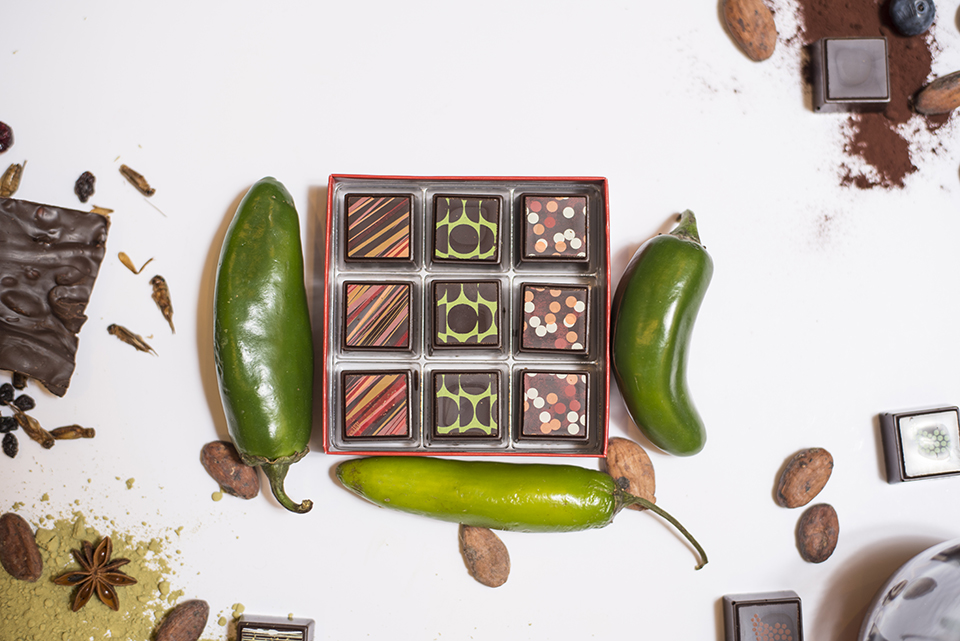Like a Box of Chocolates

Chocolate has a unique way of communicating. It can say, “I love you” or “I’m sorry” or “thank you.” We celebrate Halloween, Valentine’s Day, and birthdays with chocolates. And when we have rough days, we find solace in this sweet treat. (How convenient that it pairs so well with wine!) If you’re going to treat yourself to chocolate, it’s worth choosing a well-crafted, high quality kind. Nutrition nuts and fitness buffs who take cheat meals very seriously can rejoice in knowing that some chocolatiers make truffles that won’t induce a sugar high—and the subsequent crash.
Unnecessary Ingredients
The average, run-of-the-mill, name brand chocolate usually has a preservative (or two or three) listed in the ingredients to make production more cost-effective. Additionally, many brands include paraffin wax to create an enticing sheen. One of the most important steps in chocolate making involves tempering the liquid mix, which naturally creates a glossy appearance. This heating and cooling process must be executed properly to produce a sharp “snap” that’s characteristic of good chocolate—otherwise, the consistency will become chalky and crumbly.
The properties of cacao butter—if handled correctly—make chocolate a shelf-stable product sans additives. Anyone with Celiac disease will tell you that they’re an avid label reader because their health depends on avoiding all things gluten. Chocolate and gluten seem to be an unlikely pair, but often it’s hidden within the preservatives.
Chocolate for Purists
Most of the time, when we eat mainstream chocolate, we’re tasting a heavy dose of sugar that’s chocolate flavored rather than the true product derived from cacao beans. Artisanal chocolatiers are careful to uphold the integrity of the cacao bean throughout the process. Locally-based Delysia Chocolatier has gone to the ends of the earth (literally) to ensure the chocolate they work with is up to standard.
“We get our beans from Ghana. They’re sustainably and ethically sourced, and have documentation to prove the product is gluten-free and kosher. From there, it’s shipped to a production facility in southern Germany where it’s turned into a chocolate liquor and then imported by the pallet to Austin,” founder Nicole Patel said.
Health Benefits
Choosing a partner who keeps the chocolate as pure as possible is also important for the health benefits. Patel said another reason she picked this partner in southern Germany is because they don’t over roast the bean. “All the health benefits you find in dark chocolate are available only if they haven’t been overcooked—doing that kills the antioxidant properties.”
At Delysia Chocolatier, Patel wanted to offer something different. In the eight years they’ve been in business, dozens of unique and experimental truffle flavors have been made to fit the essence of their tagline, “for life’s every occasion.” Supporting local business is important to them as well, which has led to chocolate truffles using Salt Lick’s seasonings and barbecue sauce, Tito’s vodka, and wine from Becker Vineyards.
Keep reading for more chocolate facts!

Nicole Patel
What’s the difference between a chocolate maker and a chocolatier?
A chocolate maker works directly with cocoa beans. They roast them and turn them into chocolate. A chocolatier takes that refined chocolate and uses it to make truffles, bark, and other enhanced confections.
What’s the difference between cacao and cocoa?
Chocolate is derived from the cacao plant, which grows pods. When those pods are cracked open, inside there’s a seed called the cacao bean. The beans are processed in low heat to maintain the living enzymes, vitamins, and minerals. Cacao is high in resveratrol, a potent antioxidant.
Cocoa powders usually contain added sugar but look very similar to cacao. Cocoa powder is raw cacao that’s been roasted at high temperatures. This changes the molecular structure of the cacao bean, reducing the enzyme content and lowering the overall nutritional value.






